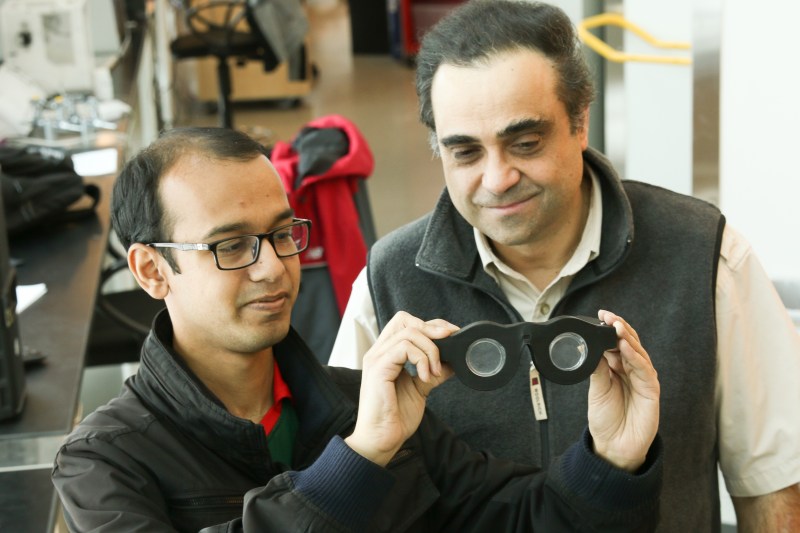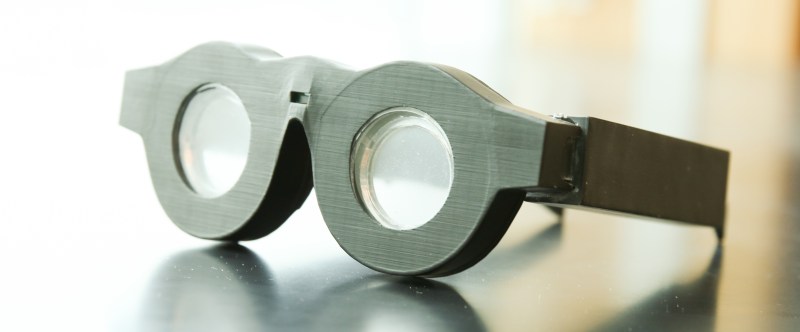A University of Utah team have a working prototype of a new twist on fluid-filled lenses for correction of vision problems: automatic adjustment and refocus depending on what you’re looking at. Technically, the glasses have a distance sensor embedded into the front of the frame and continually adjust the focus of the lenses. An 8 gram, 110 mAh battery powers the prototype for roughly 6 hours.
Eyeglasses that can adapt on the fly to different focal needs is important because many people with degraded vision suffer from more than one condition at the same time, which makes addressing their vision problems more complex than a single corrective lens. For example, many people who are nearsighted or farsighted (where near objects and far objects far objects and near objects are seen out of focus, respectively) also suffer from a general loss of the eye’s ability to change focus, a condition that is age-related. As a result, people require multiple sets of eyeglasses for different conditions. Bifocal or trifocal or progressive lenses are really just multiple sets of lenses squashed into a smaller form factor, and greatly reduce the wearer’s field of view which is itself a significant vision impairment. A full field of view could be restored if eyeglass lenses were able to adapt to different needs based on object distance, and that is what this project achieves.
A real innovation is not actually the distance-sensing part, but the adjustable lenses themselves. Lenses that can be modified dynamically using various methods (fluid pumps, etc) exist, but the team found none that:
- Had a wide enough field of view to serve effectively as corrective eyeglass lenses
- Were small and lightweight enough to use in eyeglasses
- Had minimal optical aberrations (no diffraction from fresnel grooves, no air gaps, and so forth)
In the solution the team created, the lens assembly is fluid filled and the front of the lens is a clear flexible membrane, but the rear of the lens acts as an optically clear piston controlled by three piezoelectric actuators. The design is small, light, can produce plano-convex or plano-concave lenses, and can do so quickly (within 15 ms) and with low power consumption. The full whitepaper is available online and contains details about testing, design, and construction.

[via Engadget]
















Must be what the minions use.
Cool! :D
I remember seeing a lower tech version of these. A clear balloon filled with saline in place of the lenses, then a syringe was used to change the pressure, altering the focal length.
Put an Apple logo on that and they sell them to there minions.
>>many people who are nearsighted or farsighted (where near objects and far objects are seen out of focus, respectively)
You’ve got that backwards near/far objects are IN focus if you’re near/far-sighted
Oops, what an embarrassing goof! Thanks for the catch, I somehow managed to mix that up.
Darn, I just got my new glasses..
A distance sensor, cool. (The linked article says it uses “pulses of infrared light”, so I guess time-of-flight.)
So you look out the window, and it adapts the lenses to focus on the bug-splattered glass (or else when you’re trying to clean a window, it focuses on the landscape outside); try to shoot a rifle, and it helpfully focuses on the rear sight, or the eyepiece lens of the scope.
Seriously, it’s a very cool project, but I think tracking eyeball convergence will work much better than measuring distance.
Good eyedia, but tracking eyeball convergence means it wouldn’t work for me, or many others with long-term vision problems.
Side note: I only wear safety glasses with a rifle and adjust the scope to focus, but those would be the coolest target practice goggles at the range! 8-)
Need to print them in florescent orange.
Once developed into a usable product these are going to be a boon to those of us that need eyeglasses especially as we age and our vision decays faster such that there is a decreasingly smaller window between needing to change prescriptions.
I imagine this would be a bit like when your camera tries to auto focus on the wrong thing (annoying)?
Tim Jenison in the documentary “Tim’s Vermeer” (excellent movie) had a manually adjustable pair called Superfocus glasses (no longer available).
http://www.allaboutvision.com/lenses/variable-focus.htm
Well, they do exist.
I keep seeing an infomercial at 2 in the morning with people driving while wearing them and the fine print says not to drive with them…
This will be a paradigm shift to the American optometrist cartel. I can see them requiring a visit to initialize the glasses and then “speaking of locked down options and features” the glasses will revert in one year to limited range fixed till another visit. Previous design had it fit to the wearer and then they break the knob off!
1) Battery powered
2) No user replaceable battery
3) Profit!!!
I’ve been thinking about fluid filled variable lenses years ago for eye training. Even though people selling glasses claim otherwise, I belive lots of people ruin their sight further by using their glasses for near sightness to look at near objects (like monitors at work) for hours a day. I’d love to be able to adjust my glasses so I’m just able to see, thus exercising my eyes. I know it wouldn’t work for everyone, but still.
I thought the same. Exercise glasses. But they should measure eye convergence instead of distance to be really useful for that.
A must have for gOOgle fans ;)
Liquid lenses are nothing new but their actuation method seems effective and is more out of the way than most. Using peizo material requires a 300v drive voltage though. I’m sure it’d be safe but I’d feel uncomfortable with it on my face. For experimentation purposes it’s possible to make (bulky) liquid lenses manually using syringes.
BTW, this would also be really useful in VR. You could use it to keep the display in perfect focus no matter what distance the eye was attempting to focus to. You can then feedback that focal distance to the renderer and blur anything that should not be in focus.
I’m wondering about doing it the other way. One lens per pixel, and calculating focal distance according with 3D image voxel distance from viewer, for each pixel. In this way maybe you can obtain a 3D image and force eyes to work as they’re used to. Could that add to virtual reality experience? Or at least reduce fatigue?
You aren’t quite there yet, but the idea you are thinking of is known as a near eye light field display. It’s a really awesome technology, but has quite a few technical challenges. Keeping the display always in focus with dynamic lenses would be a good way to cheat. https://www.youtube.com/watch?v=kcmD2s6E-LE
I had always assumed that the original syringe designs would evolve to use small powered plungers in the stalks & set focal distance based on minicams monitoring the eyeball convergence ( to cover for off-centre viewing). But then would be no patent to exploit & spinoff to take to market.
The ideal liquid lens is a lens replacement inside the eye & a laser reshaping of the cornea. The eye muscles then do the intended work. Oh wait, that’s current tech for UK. Bah humbug.
My vision is not good at any distance. Near sighted, left astigmatism, another (rare?) unnamed issue that prevents the use of optical land surveying equipment. May I please be a tester of the product?